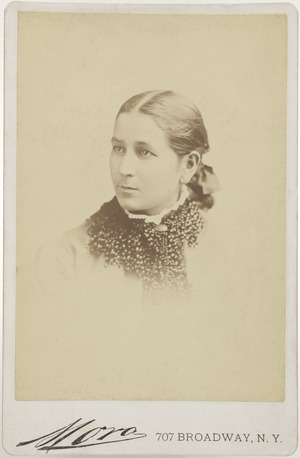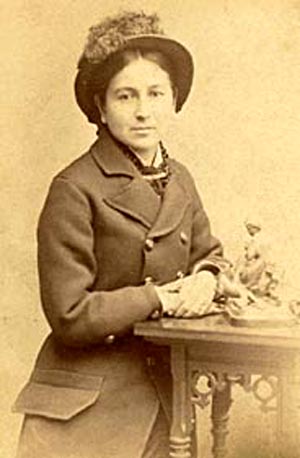Susette La Flesche facts for kids
Quick facts for kids
Susette La Flesche
|
|
|---|---|
| Inshata Theumba | |
 |
|
| Born | 1854 |
| Died | 1903 |
| Occupation | Writer, lecturer, interpreter, artist |
| Known for | Native American rights activism |
| Spouse(s) | |
| Parent(s) | Joseph LaFlesche and Mary Gale |
| Relatives |
|
Susette La Flesche, also known as Inshata Theumba (meaning "Bright Eyes"), was an important Native American woman. She was born in 1854 and passed away in 1903. Susette was a talented writer, speaker, interpreter, and artist.
She belonged to the Omaha tribe in Nebraska. Susette La Flesche was a strong supporter of progress and spoke up for the rights of Native American people. Her family background included Ponca, Iowa, French, and Anglo-American roots. She was honored for her work by being added to the Nebraska Hall of Fame in 1983. Later, in 1994, she was also inducted into the National Women's Hall of Fame.
Contents
Growing Up and Learning
Susette, or Inshata Theumba, was born in Bellevue, Nebraska, in 1854. She was the oldest daughter of five children. Her parents were Joseph LaFlesche and Mary Gale. Joseph La Flesche was the son of a French fur trader. His mother was a Ponca woman named Waoowinchtcha.
Joseph La Flesche was adopted by the Omaha chief Big Elk. He later became the last traditional chief of the Omaha. The La Flesche family was well-known and wealthy among the Omaha.
Susette's parents believed education was very important for their children. They thought it would help their people have a better future. They supported missionary schools for their kids. Joseph also had another wife, Ta-in-ne, and they had a son named Francis La Flesche in 1857.
From 1862 to 1869, Susette went to the Presbyterian Mission Boarding Day School. There, she learned to read, write, and speak English. She also learned cooking and sewing skills. After this school closed, Susette went to a girls' school in Elizabeth, New Jersey. Her younger sisters, Marguerite and Susan, followed her there. Susette's writing talents were noticed and encouraged during her school years.
Susette's brothers and sisters also became successful professionals. Her sister, Susan LaFlesche Picotte, became the first Native American doctor. She even started the first hospital on an Indian reservation that was paid for by private money. Another sister, Rosalie La Flesche Farley, managed money for the Omaha nation. She helped lease grazing land that was not being used.
Marguerite LaFlesche Picotte became a teacher on the Yankton Sioux reservation. Her half-brother, Francis LaFlesche, became an ethnologist. He worked for the Smithsonian Institution. He wrote about the Omaha and the Osage people. He also made recordings of their traditional songs.
Her Important Work
As a young woman, Susette La Flesche became very interested in politics. After finishing school, she wanted to be a teacher on the Omaha reservation. At first, she faced many challenges. She needed a certificate to teach. She wrote letters and even threatened to tell newspapers about her struggles. Finally, she got permission to teach. She became the first Native American teacher on the Omaha reservation. She even bought an organ to teach her students music.
Susette's grandmother and uncle were Ponca people. So, Susette and her father traveled to Oklahoma. They wanted to see how the Ponca tribe was doing. The U.S. government had forced the Ponca to move from Nebraska. This move was called removal.
Susette worked with Thomas Tibbles, a newspaper editor. They told people about the terrible conditions the Ponca faced. The Ponca had moved too late in the year to plant crops. The government was slow to provide supplies. Many Ponca people got sick with malaria. Nearly one-third of the tribe died in the first two years.
Chief Standing Bear's oldest son died during this time. The chief left the Indian Territory to bury his son in Nebraska. He and his followers were arrested. Thomas Tibbles wrote about Chief Standing Bear's arrest. This helped Standing Bear get free legal help.
In 1879, Susette La Flesche helped Chief Standing Bear in his trial. She was his interpreter at Fort Omaha. She also spoke about the bad conditions on the reservation. Chief Standing Bear argued that Native Americans were "persons" under the law. He said they had the same rights as other U.S. citizens. The judge agreed with him. This case, Standing Bear v. Crook, was a very important civil rights case.
After the trial, Susette, her half-brother Francis, and Chief Standing Bear went on a speaking tour. They traveled across the eastern United States. Susette helped interpret for Chief Standing Bear. She also gave her own speeches. They met famous writers like Henry Wadsworth Longfellow and Helen Hunt Jackson. Helen Hunt Jackson later wrote a book about how the U.S. government treated Native Americans.
In 1887, Susette La Flesche and Thomas Tibbles, who were now married, went to England and Scotland. They continued to speak about Native American issues. Many people wanted to learn more about these important topics.
Later, Susette and Thomas became interested in the Ghost Dance movement. They visited the Pine Ridge Indian Reservation in 1890. They wrote about the conditions there. They also wrote about the Wounded Knee Massacre. This was a very important part of Susette's writing career. She continued to write articles for newspapers in Nebraska.
Her Family Life
Susette La Flesche married Thomas Tibbles in July 1881. They spent some time in Washington, D.C., but mostly lived in Nebraska. While in Washington, Susette continued to write and give talks about Native American issues. She spoke about "The Position, Occupation, and Culture of Indian Women."
In Nebraska, she spent time farming on her land. This land was given to her as a member of the Omaha tribe. She also continued her writing. Her husband helped manage her father's property.
Her Writings
Susette La Flesche wrote several important works:
- "Nedawi: An Indian Story from Real Life" was published in a children's magazine in 1881. This is believed to be the first short story written by a Native American that was not based on a legend.
- She co-wrote and illustrated the book Oo-mah-ha Ta-wa-tha (1898) with Fannie Reed Griffin.
- She wrote the introduction and illustrated the novel Ploughed-Under: The Story of an Indian Chief, as Told by Himself (1881).
- She also wrote the introduction to The Ponca Chiefs, a book by Thomas Tibbles.
- Susette wrote columns for the Omaha World Herald and her husband's newspaper, The Independent.
Honors and Remembering Her
- In 1903, after she passed away, Susette LaFlesche Tibbles was praised in the U.S. Senate.
- In 1983, she was inducted into the Nebraska Hall of Fame. This honored her role as a speaker and writer for her people.
- In 1994, she was inducted into the National Women's Hall of Fame.
Images for kids
See also
 In Spanish: Susette La Flesche para niños
In Spanish: Susette La Flesche para niños




